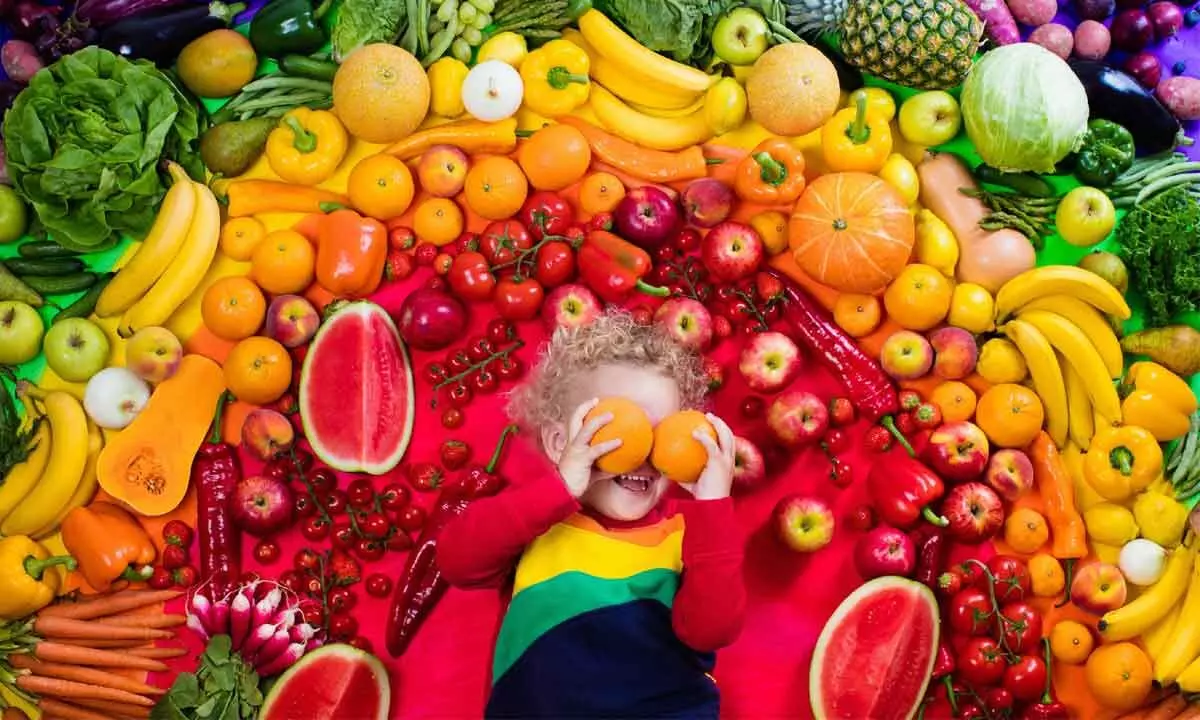Live
- The Changing Situation of Global Trading
- They always want me to win, and now I feel lucky to have been offered a story like ‘Zebra’: Satyadev Kancharana
- ‘Democracy first, humanity first’: PM Modi in Guyana's parliament on two countries' similarities
- PKL Season 11: Telugu Titans register third straight win to top standings
- Is Pollution Contributing to Your COPD?
- NASA Unveils Underwater Robots for Exploring Jupiter's Moons
- Additional Central forces arrive in violence-hit Manipur
- AR Rahman and Saira Banu’s Divorce: Legal Insights into Common Issues in Bollywood Marriages
- 82.7 pc work completed in HPCL Rajasthan Refinery area: official
- Curfew relaxation extended in 5 Manipur districts on Friday
Just In
Rainbow Taste: Go for colourful diet


Rainbow Taste: Go for colourful diet
Nutritionists will tell you to eat a rainbow of fruit and vegetables
Nutritionists will tell you to eat a rainbow of fruit and vegetables. This isn't just because it looks nice on the plate. Each colour signifies different nutrients our body needs.
The nutrients found in plant foods are broadly referred to as phytonutrients. There are at least 5,000 known phytonutrients, and probably many more. So what does each colour do for our body and our overall health?
Red
Red fruits and vegetables are coloured by a type of phytonutrient called "carotenoids" (including ones named lycopene, flavones and quercetin – but the names aren't as important as what they do). These carotenoids are found in tomatoes, apples, cherries, watermelon, red grapes, strawberries and capsicum. These carotenoids are known as antioxidants. It has something to do with "free radicals," which are formed naturally in our body as a byproduct of all our usual bodily processes such as breathing and moving, but they also come from UV light exposure, smoking, air-pollutants and industrial chemicals. Free radicals are unstable molecules that can damage proteins, cell membranes and DNA in our body. Antioxidants stabilise the free radicals so they no longer cause damage. Increasing antioxidants in your diet lowers oxidative stress and reduces the risk of many diseases including arthritis, type 2 diabetes, heart disease, stroke and cancer.
Orange
Orange fruits and vegetables also contain carotenoids, but slightly different ones to red veggies (including alpha and beta-carotene, curcuminoids, and others). These are found in carrots, pumpkins, apricots, mandarins, oranges and turmeric. Alpha and beta-carotene are converted to vitamin A in our bodies, which is important for healthy eyes and good eyesight. Vitamin A is also an antioxidant that can target the parts of your body made of lipids (or fats) such as cell membranes. The vitamin A targets the free radicals building up around our cell membranes and other areas made of lipids, reducing the risk of cancers and heart disease.
Yellow
Yellow fruit and vegetables also contain carotenoids, but they also contain other phytonutrients including lutein, zeaxanthin, meso-zeaxanthin, viola-xanthin and others. These are found in apples, pears, bananas, lemons and pineapple. Lutein, meso-zeaxanthin and zeaxanthin have been shown to be particularly important for eye health and can reduce the risk of age-related macular degeneration, which leads to blurring of your central vision. These phytonutrients can also absorb UV light in your eyes, acting like a sunscreen for the eyes and protecting them from sun damage.
Green
Green fruits and vegetables contain many phytonutrients including chlorophyll (which you probably remember from high school biology), catechins, epigallocatechin gallate, phytosterols, nitrates and also an important nutrient known as folate (or vitamin B9). These are found in avocados, Brussels sprouts, apples, pears, green tea and leafy vegetables. These also act as antioxidants. But this group also keeps your blood vessels healthy, by promoting something called "vasodilation." These phytonutrients help make our blood vessels more elastic and flexible allowing them to widen or dilate.
Blue and purple
Blue and purple produce contain other types of phytonutrients including anthocyanins, resveratrol, tannins and others. They are found in blackberries, blueberries, figs, prunes and purple grapes. Anthocyanins also have antioxidant properties and so provide benefits in reducing the risk of cancer, heart disease and stroke, as explained under red fruit and veg. More recent evidence has indicated they may also provide improvements in memory. It is thought this occurs by improving signalling between brain cells and making it easier for the brain to change and adapt to new information (known as brain plasticity).
Brown and white
Brown and white fruits and vegetables are coloured by a group of phytonutrients known as "flavones", this includes apigenin, luteolin, isoetin and others. These are found in foods such as garlic, potatoes and bananas. Another phytonutrient found in this colour of vegetables, particularly in garlic, is allicin. Allicin has been shown to have anti-bacterial and anti-viral properties.
Coloured fruit and vegetables, and also herbs, spices, legumes and nuts provide us with a plethora of phytonutrients.. Buy different colours of the fruit and vegetables you normally eat like apples, grapes, onions and lettuces. Eat the skins, as the phytonutrients may be present in the skin in higher amounts. Don't forget herbs and spices also contain phytonutrients, add them to your cooking as well (they also make vegetables more appealing!)
(The Conversation)

© 2024 Hyderabad Media House Limited/The Hans India. All rights reserved. Powered by hocalwire.com






